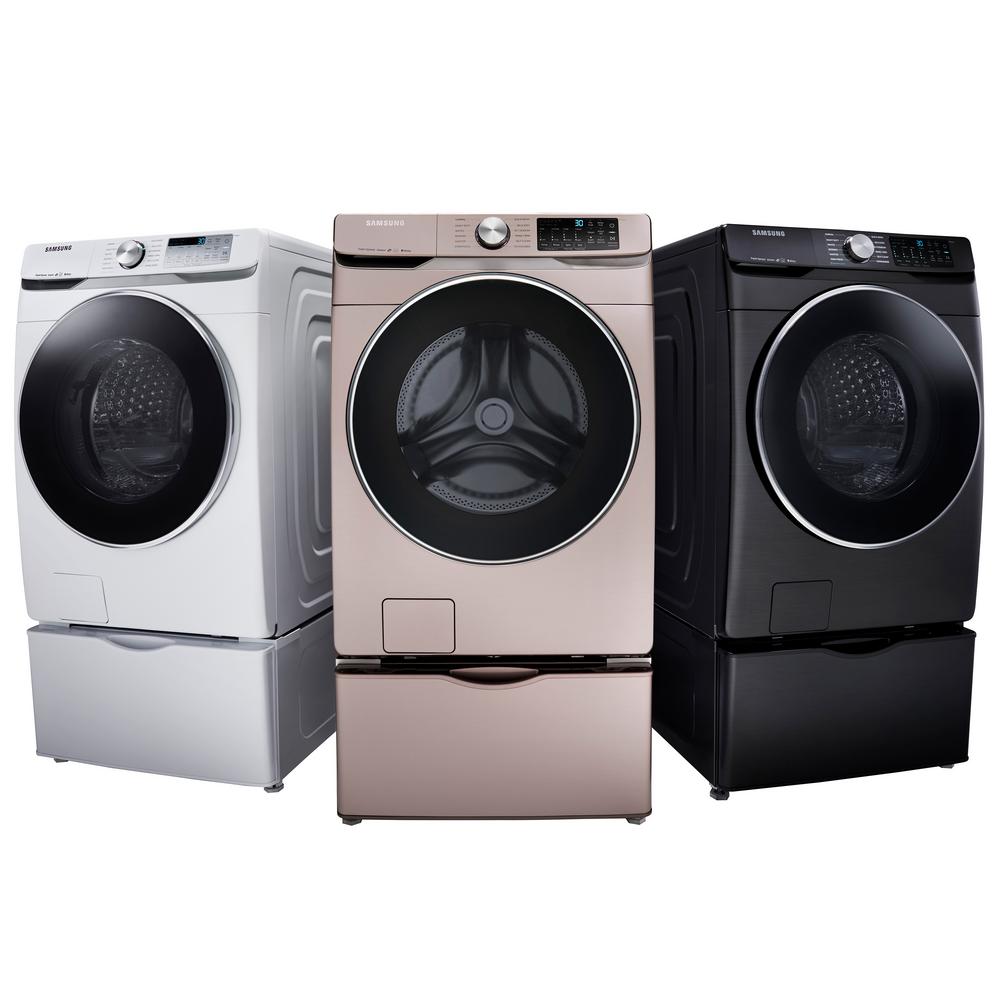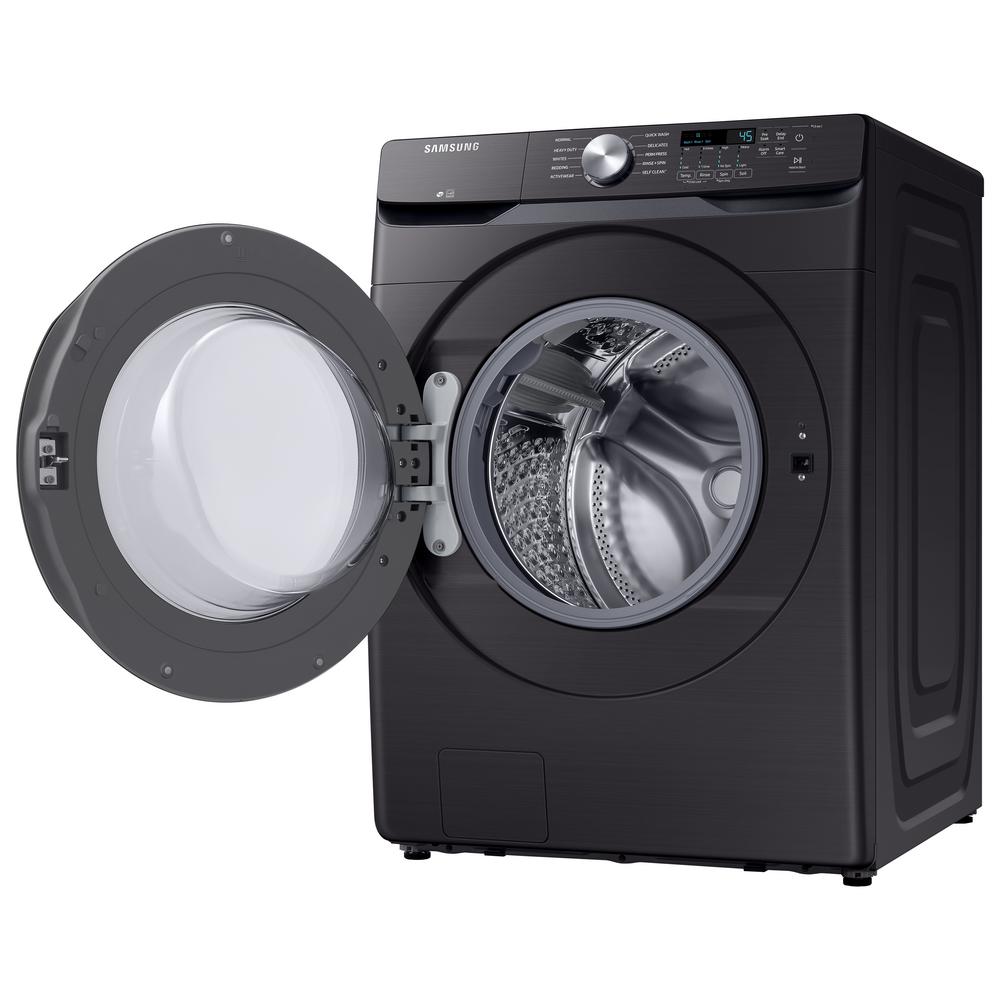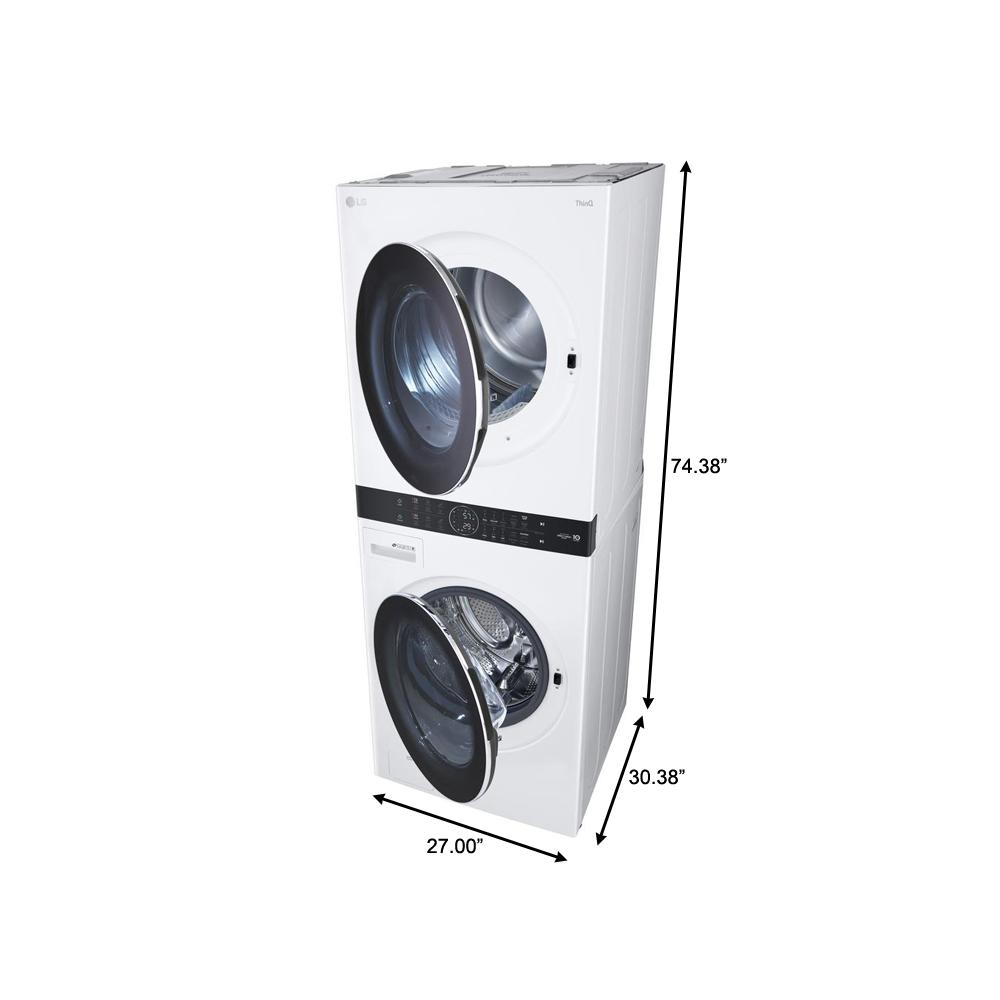LG 7.4 cu. ft. Ultra Large Black Steel Smart Electric Vented Dryer with Sensor Dry, TurboSteam and Wi-Fi Enabled
7.4 cu. ft. ultra large capacity. Electric Dryer pairs best with LG WM4000HBA Washer. TurboSteam technology.
Meet the intelligent dryer that helps you save time and enhances fabric care, all at the same time. TurboSteam technology reduces wrinkles and odors in up to 5 garments to refresh clothes in between washes. Built-in intelligence automatically selects the right drying motions, temperatures and more, and even talks to your washer to select a compatible cycle-making it the ultimate laundry hack. You’ll even score high on the durability and style scale, thanks to the scratch-resistant tempered glass door and rose gold accents.
- Free up your day-fit more clothes in every load with 7.4 cu. ft. of space, running fewer loads saves energy and money on your utility bill
- Steam refresh clothes in between washes, refresh instantly with TurboSteam that generates steam penetrating deep into fabrics
- Built-in intelligence takes out the guesswork – AI technology selects optimal dry motions and settings, washer can auto-select a compatible drying cycle
- With sensor dry, the dryer can detect moisture and automatically adjust drying time for loads of all sizes – saving energy with less wear and tear on clothes
- LG front load washers and dryers are the first to use tempered glass doors for a sleek, stylish look that resists shock and scratches, the premium feel is further enhanced by matching door trim and control knob accents
- FlowSense duct clogging indicator will tell you when it’s time to clean the ducts out, clean ducts mean a great drying every time
- High efficiency sensor drying and low-heat settings save energy and money by using about 20% less energy than conventional models without sacrificing features or performance
- Handles surprisingly big loads with a compact, closet depth design that offers plenty of installation options
- Aluminized alloy steel drum has toughness and an attractive finish that will last for years
- Designed for quiet operation, run the dryer without interrupting naptime or your favorite show
- Dryer door can easily be reversed from a right swing to a left swing in minutes to give you more installation options
- Periodically tumbles dry for up to 3 hours after the cycle is done to help keep wrinkles at bay
Additional information
| Depth With Door Open 90 Degrees (In) | 51.38 |
|---|---|
| Door Opening Height x Width (In.) | 16.06 x 16.06 |
| Product Depth x Height x Width (in.) | 30.12 x 39 x 27 |
| Certifications and Listings | CSA Listed,Energy Star |
| Manufacturer Warranty | Limited warranty: 1 Year Parts & Labor, 10 Years Drum |
4 (four) is a number, numeral and digit. It is the natural number following 3 and preceding 5. It is a square number, the smallest semiprime and composite number, and is considered unlucky in many East Asian cultures.
7
7 (seven) is the natural number following 6 and preceding 8. It is the only prime number preceding a cube.
As an early prime number in the series of positive integers, the number seven has greatly symbolic associations in religion, mythology, superstition and philosophy. The seven classical planets resulted in seven being the number of days in a week. 7 is often considered lucky in Western culture and is often seen as highly symbolic. Unlike Western culture, in Vietnamese culture, the number seven is sometimes considered unlucky.
Black is a color that results from the absence or complete absorption of visible light. It is an achromatic color, without hue, like white and grey. It is often used symbolically or figuratively to represent darkness. Black and white have often been used to describe opposites such as good and evil, the Dark Ages versus Age of Enlightenment, and night versus day. Since the Middle Ages, black has been the symbolic color of solemnity and authority, and for this reason it is still commonly worn by judges and magistrates.
Black was one of the first colors used by artists in Neolithic cave paintings. It was used in ancient Egypt and Greece as the color of the underworld. In the Roman Empire, it became the color of mourning, and over the centuries it was frequently associated with death, evil, witches, and magic. In the 14th century, it was worn by royalty, clergy, judges, and government officials in much of Europe. It became the color worn by English romantic poets, businessmen and statesmen in the 19th century, and a high fashion color in the 20th century. According to surveys in Europe and North America, it is the color most commonly associated with mourning, the end, secrets, magic, force, violence, fear, evil, and elegance.
Black is the most common ink color used for printing books, newspapers and documents, as it provides the highest contrast with white paper and thus is the easiest color to read. Similarly, black text on a white screen is the most common format used on computer screens. As of September 2019, the darkest material is made by MIT engineers from vertically aligned carbon nanotubes.
Dry or dryness most often refers to:
- Lack of rainfall, which may refer to
- Arid regions
- Drought
- Dry or dry area, relating to legal prohibition of selling, serving, or imbibing alcoholic beverages
- Dry humor, deadpan
- Dryness (medical)
- Dryness (taste), the lack of sugar in a drink, especially an alcoholic one
- Dry direct sound without reverberation
Dry or DRY may also refer to:
LG Corporation (or LG Group), formerly known as Lucky-Goldstar, is a South Korean multinational conglomerate founded by Koo In-hwoi and managed by successive generations of his family. It is the fourth-largest chaebol (family-run conglomerate) in South Korea. Its headquarters are in the LG Twin Towers building in Yeouido-dong, Yeongdeungpo District, Seoul. LG makes electronics, chemicals, household appliances, and telecommunications products and operates subsidiaries such as LG Electronics, Zenith, LG Display, LG Uplus, LG Innotek, LG Chem, and LG Energy Solution in over 80 countries. According to the “Top 500 Global Brands” released by British consulting firm Brand finance, LG's brand value ranking rose from 90th to 83rd from the previous year.
A sensor is a device that produces an output signal for the purpose of detecting a physical phenomenon.
In the broadest definition, a sensor is a device, module, machine, or subsystem that detects events or changes in its environment and sends the information to other electronics, frequently a computer processor.
Sensors are used in everyday objects such as touch-sensitive elevator buttons (tactile sensor) and lamps which dim or brighten by touching the base, and in innumerable applications of which most people are never aware. With advances in micromachinery and easy-to-use microcontroller platforms, the uses of sensors have expanded beyond the traditional fields of temperature, pressure and flow measurement, for example into MARG sensors.
Analog sensors such as potentiometers and force-sensing resistors are still widely used. Their applications include manufacturing and machinery, airplanes and aerospace, cars, medicine, robotics and many other aspects of our day-to-day life. There is a wide range of other sensors that measure chemical and physical properties of materials, including optical sensors for refractive index measurement, vibrational sensors for fluid viscosity measurement, and electro-chemical sensors for monitoring pH of fluids.
A sensor's sensitivity indicates how much its output changes when the input quantity it measures changes. For instance, if the mercury in a thermometer moves 1 cm when the temperature changes by 1 °C, its sensitivity is 1 cm/°C (it is basically the slope dy/dx assuming a linear characteristic). Some sensors can also affect what they measure; for instance, a room temperature thermometer inserted into a hot cup of liquid cools the liquid while the liquid heats the thermometer. Sensors are usually designed to have a small effect on what is measured; making the sensor smaller often improves this and may introduce other advantages.
Technological progress allows more and more sensors to be manufactured on a microscopic scale as microsensors using MEMS technology. In most cases, a microsensor reaches a significantly faster measurement time and higher sensitivity compared with macroscopic approaches. Due to the increasing demand for rapid, affordable and reliable information in today's world, disposable sensors—low-cost and easy‐to‐use devices for short‐term monitoring or single‐shot measurements—have recently gained growing importance. Using this class of sensors, critical analytical information can be obtained by anyone, anywhere and at any time, without the need for recalibration and worrying about contamination.
Smart may refer to a high level of intelligence or "street smarts".
"Smart" or SMART may also refer to the following.
Steel is an alloy of iron and carbon with improved strength and fracture resistance compared to other forms of iron. Because of its high tensile strength and low cost, steel is one of the most commonly manufactured materials in the world. Steel is used in buildings, as concrete reinforcing rods, in bridges, infrastructure, tools, ships, trains, cars, bicycles, machines, electrical appliances, furniture, and weapons.
Iron is always the main element in steel, but many other elements may be present or added. Stainless steels, which are resistant to corrosion and oxidation, typically need an additional 11% chromium.
Iron is the base metal of steel. Depending on the temperature, it can take two crystalline forms (allotropic forms): body-centred cubic and face-centred cubic. The interaction of the allotropes of iron with the alloying elements, primarily carbon, gives steel and cast iron their range of unique properties. In pure iron, the crystal structure has relatively little resistance to the iron atoms slipping past one another, and so pure iron is quite ductile, or soft and easily formed. In steel, small amounts of carbon, other elements, and inclusions within the iron act as hardening agents that prevent the movement of dislocations.
The carbon in typical steel alloys may contribute up to 2.14% of its weight. Varying the amount of carbon and many other alloying elements, as well as controlling their chemical and physical makeup in the final steel (either as solute elements, or as precipitated phases), impedes the movement of the dislocations that make pure iron ductile, and thus controls and enhances its qualities. These qualities include the hardness, quenching behaviour, need for annealing, tempering behaviour, yield strength, and tensile strength of the resulting steel. The increase in steel's strength compared to pure iron is possible only by reducing iron's ductility.
Steel was produced in bloomery furnaces for thousands of years, but its large-scale, industrial use began only after more efficient production methods were devised in the 17th century, with the introduction of the blast furnace and production of crucible steel. This was followed by the Bessemer process in England in the mid-19th century, and then by the open-hearth furnace. With the invention of the Bessemer process, a new era of mass-produced steel began. Mild steel replaced wrought iron. The German states were the major steel producers in Europe in the 19th century. American steel production was centred in Pittsburgh, Bethlehem, Pennsylvania, and Cleveland until the late 20th century. Currently, world steel production is centered in China, which produced 54% of the world's steel in 2023.
Further refinements in the process, such as basic oxygen steelmaking (BOS), largely replaced earlier methods by further lowering the cost of production and increasing the quality of the final product. Today more than 1.6 billion tons of steel is produced annually. Modern steel is generally identified by various grades defined by assorted standards organizations. The modern steel industry is one of the largest manufacturing industries in the world, but also one of the most energy and greenhouse gas emission intense industries, contributing 8% of global emissions. However, steel is also very reusable: it is one of the world's most-recycled materials, with a recycling rate of over 60% globally.
With or WITH may refer to:
- With, a preposition in English
- Carl Johannes With (1877–1923), Danish doctor and arachnologist
- With (character), a character in D. N. Angel
- With (novel), a novel by Donald Harrington
- With (album), a 2014 album by TVXQ
- With (EP), a 2021 EP by Nam Woo-hyun






by Mike
Extra features are great. Bought this a month ago and enjoy being able to add calls during the wash cycle.
by Lizin
I’ve had this for a month now. It washes great. I wish that it had regular features. It gives me ore-programmed options and doesn’t let me select temp-etc for some of the options that so want.
by Basil
Super fast drying times
by Armold
We bought this about a month ago all of our clothes dry really fast and it’s easy to use.
by James
The washer and dryer exceeded my expectations, they are beautiful and very easy to use.
by Dennis
The LG dryer and washer are awesome, but home depot set up wasn’t good. They connected hoses wrong, and put the dryer and washer on the wrong side of each other so that the doors were in the way. They also would not put them on the LG drawers since we didn’t purchase them through Home Depot. My father and I had to disconnect everything, put them on the drawers, then reconnect everything correctly. I suggest having Home Depot deliver, but hook them up yourself and save yourself time and money.